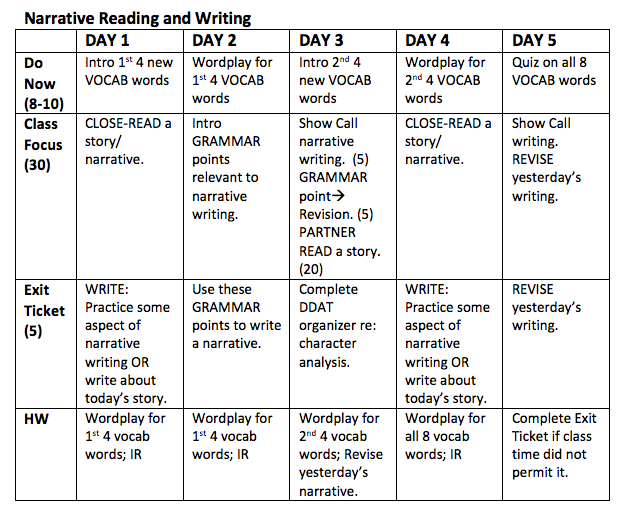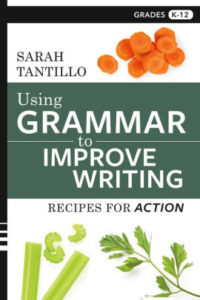Blending Grammar into Daily ELA Instruction

One of the most common concerns I hear from ELA teachers is “I want to teach grammar, but I’m not sure how to fit it in.” This post explains a systematic approach.
As a general rule, before you write detailed lesson plans, it helps to create a 35,000-foot overview that captures your weekly routines. Over the course of the year, depending on the genre(s) you’re focusing on, you might revise these routines.1
Below is a sample overview that maps out ways to integrate whole-class vocabulary, reading, and grammar/writing work with narrative reading and writing activities—shifting the focus of the work accordingly.
This generic overview can be modified based on the grade level(s) you teach, and it assumes you have at least 45 minutes of ELA instruction per day. If you have more time, great. If you have less, you might need to adjust your plans. Or change your schedule.
- Regarding Do Nows, the assumption is that students will spend 3-5 minutes (max) doing the work, then another 3-5 minutes going over it (so: 8-10 minutes total). For details on how to design and implement vocabulary instruction, see my MiddleWeb post.
- An Exit Ticket may take more than 5 minutes (e.g., a paragraph that students begin writing during the Class Focus time might require 10-15 minutes); in that case, the Exit Ticket is more a reflection of what you intend to collect.
- Regarding homework (HW), I recommend including independent reading (IR) on top of whatever else you require. It never hurts to remind students to read.
- Please note these are rough outlines for a five-day cycle. Day 1 doesn’t have to be Monday. And if you’re on a six-day cycle, simply add a column.
DAY 1 NOTES:
- Early in the year, it helps to review the most important reading standard, RL 2.1: Ask and answer such questions as who, what, where, when, why, and how to demonstrate understanding of key details in a text. For more on this standard, check out this post.
- For another effective approach to close reading, check out this post.
DAY 2 NOTES:
Which grammar points should you target? Here are three options—and you will probably use all of them:
- A quick scan of students’ Exit Tickets after class will help you identify immediate needs.
- If students are writing stories/narratives, consider grammar standards that relate particularly to that genre, such as L 3.2.c: Use commas and quotation marks in dialogue.
- Take a look at this K-12 Language Standards Tracker (free Excel download), beginning with the kindergarten level, to see where your students need support.
DAY 3 NOTES:
- “Show Call” is Doug Lemov’s visual variation on cold-calling: You select a student’s paper to share with the class to provide public feedback as a way to teach revising and editing. For a detailed explanation, see Lemov’s Teach Like a Champion 2.0: 62 Techniques That Put Students on the Path to College (Jossey-Bass, 2015), pp. 290-299. Lemov has some discussion about Show Call in this blog post.
- Make sure partner reading has a clear purpose. Check out this post.
- For an explanation of the DDAT organizer, check out this post.
The text for this day might be a continuation of the text from Day 1, or it might be a different text altogether.
DAY 5 NOTES:
During the Class Focus, while students are revising, you can (and should) conduct writing conferences; students might also employ the Partner Feedback Protocol. For an explanation of these revision strategies, check out this post.
Here’s the bottom line:
It’s easy to get pulled into emphasizing aspects of the curriculum that we feel comfortable with. Taking a systematic approach such as this one can make it easier to ensure that we fit EVERYTHING in.
1 This post is derived from Using Grammar to Improve Instruction: Recipes for Action by Sarah Tantillo (BookBaby, 2018). To see sample overview maps for other genres, check out pp. 262-266.
__________________________________

Sarah consults with schools on literacy instruction, curriculum development, data-driven instruction, and school culture building. She taught English and Humanities in both suburban and urban public schools, including the high-performing North Star Academy Charter School of Newark. For more information visit her website The Literacy Cookbook and her TLC Blog.





































